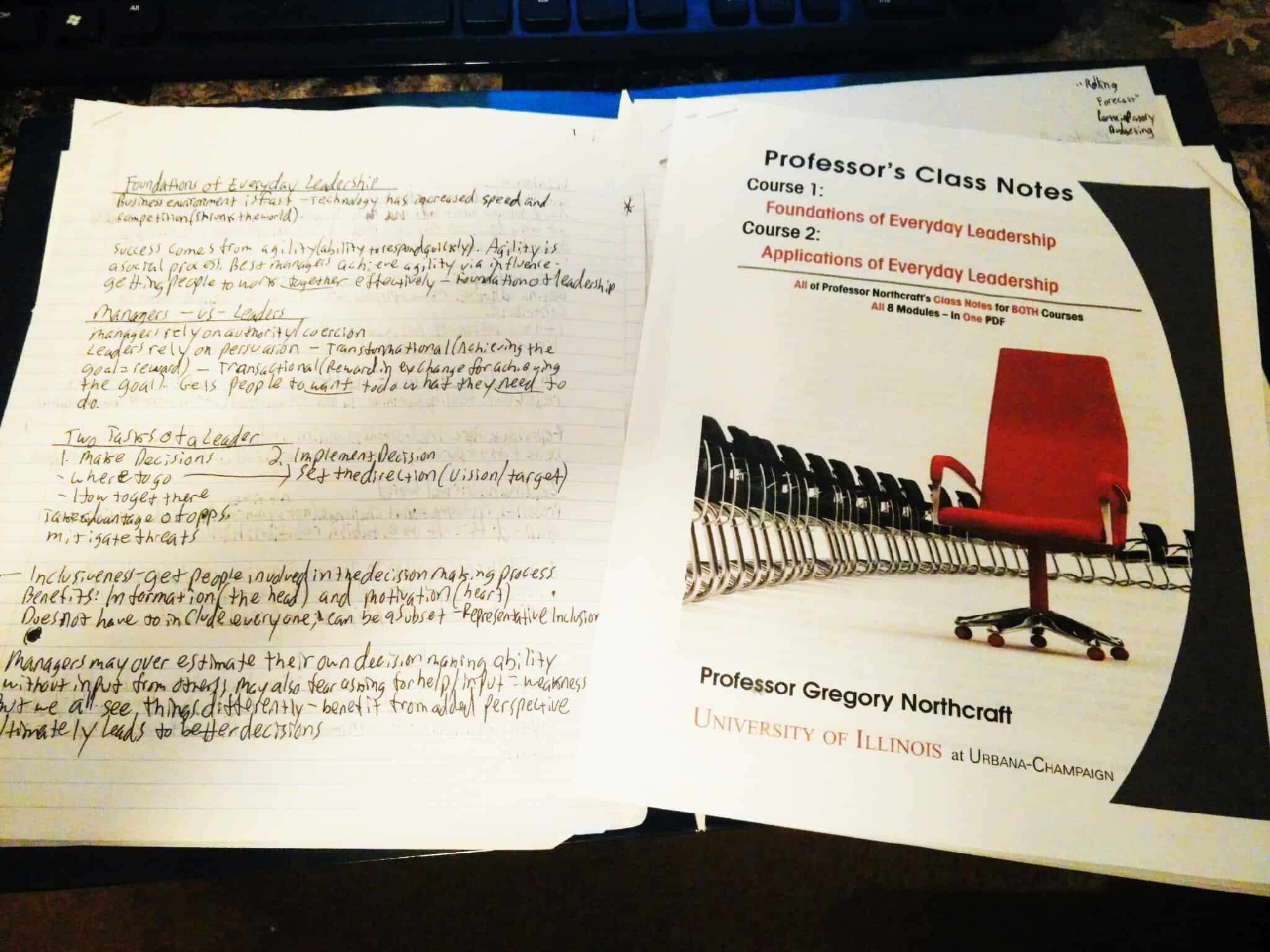In-Depth Review: Foundations of Everyday Leadership
Detailed review by Class Central user on a course that will help you motivate teams and create harmony and congruence within them.
INTRODUCTION
It is easy to assume that being in a management or supervisory position makes us a leader by default. **SPOILER ALERT*** It doesn’t and Foundations of Everyday Leadership will help you understand why. Anyone who has been charged with leading others can tell you at least one story of an abysmal failure, e.g. an inability to motivate their team or falling short of a huge goal. I am certainly no exception so I took this course in the hopes that I could understand how to create harmony and congruency with teams as we work toward our shared mission.
SPECIALIZATION
Foundations of Everyday Leadership is the first of seven courses in the Strategic Leadership and Management specialization offered by the University of Illinois on Coursera. Students can complete individual courses or the entire specialization. Students also have the option to complete the specialization for college credit by earning either a standalone certificate or fulfilling part of the requirements toward the university’s iMBA degree program (both of which require a separate application through the university).
LECTURER
The course is taught by Dr. Gregory Northcraft who is the Harry J. Gray Professor of Executive Leadership in the Department of Business Administration and a professor in the Institute of Labor and Industrial Relations at the University of Illinois. He has an incredible academic pedigree having studied at Dartmouth, Oxford, and Standard. Dr. Northcraft has been published in several academic journals and is considered to be one of the foremost experts in leadership thought.
BACKGROUND
I entered this course holding an MBA and a master’s degree leadership along with direct supervisory experience. My training has included coursework on topics such as Servant Leadership, Managing Change, Human Resource Management, and many others. One thing about some of us MBA’s, though, is that we are sometimes viewed as being long on management thought and short on leadership skill. I wanted to defy that perception.
SUCCESS
Don’t worry about having a particular set of skills or abilities prior to enrolling in this course. If you have a willingness to listen and a desire to become a better leader you already possess everything you need to be successful in this course. You must understand and accept that your leadership journey really isn’t about you – it’s about those you are leading.
THE COURSE
Foundations of Everyday Leadership is designed to be completed in four weeks, but can be completed in less time. It is divided into four modules:
• Module 1: Head and Heart of Everyday Leadership provides an introduction into the leadership essentials each of us must leverage to get into the heads and hearts of those we lead. This module concludes with a written case study assignment.
• Module 2: Individual Decision Making provides insight on decision analysis along with the many shortcomings of trying to make decisions on our own. The guiding principle is that there will always be those who know something we don’t so we need to ask them. This module concludes with a short quiz.
• Module 3: Group Decision Making helps the leader overcome the pitfalls of making individual decisions by building a strong network of diverse employees devoted to achieving it. This module concludes with a written case study assignment.
• Module 4: Managing Motivation really puts a nice bow on this course. The discussion on expectancy theory and overcoming issues of perception were immeasurably beneficial insights to me. This module concludes with a short quiz.
Staying true to form, Foundations of Everyday Leadership requires group work to complete two case studies in Modules 1 & 3. You can ask either your friends or colleagues to participate or, as many students have done, ask your fellow students to assist you. Each person will review the case and offer his/her insight which the student will use to formulate a response. Note that written assignments are limited to 120 words which requires some deeply critical thinking to achieve.
The instructor also provides the option of purchasing a compilation of the supplemental readings for $85.00 USD and two page summaries of each module for $6.00. I did not purchase the supplemental readings, but I did purchase the two page summaries. They provide a very good “cheat sheet” that you can use as reference in the future.

My individual notes and the available two page summaries
GRADING
Some of the questions on the exams are not presented linearly meaning they won’t be phrased verbatim as they were written or spoken in the texts and lectures. Here again you have to think critically and really try to absorb the content. It is nearly impossible to just skim the material and expect to do well.
The written case studies are peer reviewed. Students have to submit their written assignment first and then grade at least three peers in order for their assignment to become available for peer review. The peer review process, as many are aware, has benefits and drawbacks. It is always helpful to look at situations from multiple perspectives, but I encountered some frustrations with the peer reviews in this course for two reasons: 1) Students don’t know the specific grading criteria until after the assignment is submitted and it’s time to do peer reviews 2) While I personally felt I adequately address many of the questions raised, some of my peer reviews appeared to be looking for black/white responses and failed to understand the context of what I was writing (though I concede I may bear much of the blame of that).
I tell you this because you may encounter the same problem. Remember that if you do not get a passing score or you are not happy with the score you received the assignment can be re-submitted. Just take special precautions to review the grading criteria and carefully consider how you have phrased things (don’t assume others will get the gist of your answer). I found that simple = better.
TIME COMMITMENT
It is suggested that students will need to spend approximately 4 – 6 hours per week to complete this course. I managed to complete this course in just over two weeks, but the time it takes to complete the course is contingent on a variety of factors including individual motivation, etc. so it may take you more or even less time to complete the course. You will get out of it everything that you put into it.
BOTTOM LINE
This course has had a profound impact on how I view leadership. I understand that genuinely effective leaders pull the lever on making a decision only when they have rallied the support and gathered the perspectives of those who will be affected by the decision. If you want an introductory lesson on how to do this then I implore you take this course. You won’t regret it.
WHAT’S NEXT?
As the name implies, this course provides a foundation for everyday leadership. The next course in the series, Applications of Everyday Leadership, is designed to help us put the tools to work.
NOTE: This article was not written by Pat, it was written by a learner who wishes to be anonymous.






